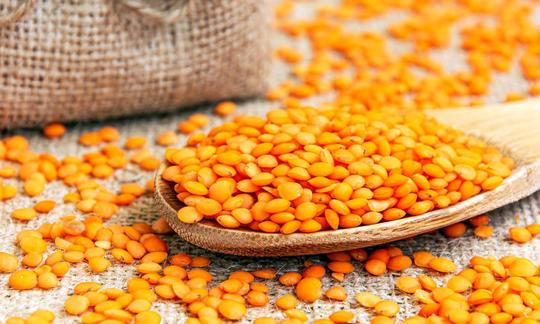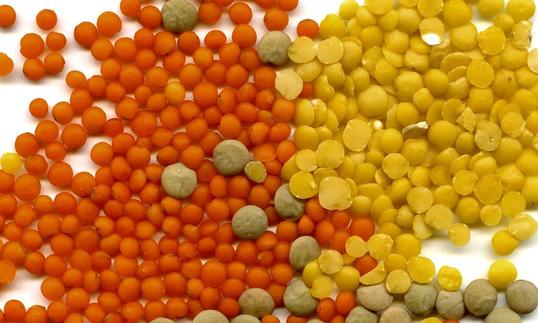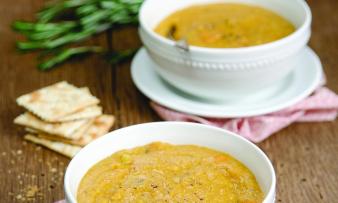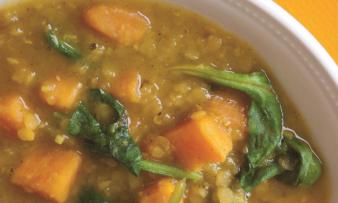Red lentils ( Lens culinaris , Erve, kitchen lentil) come from India and Turkey. They are commercially available dried. They are already peeled and can be cooked quickly and easily.
Use in the kitchen:
Lentils are a very good source of protein and are easier on the digestive system than beans or peas. They can only be eaten raw after soaking or in sprouted form. They should be washed before cooking or soaked overnight in water for a shorter cooking time and then cooked in fresh water. 1 If you puree the lentils, as in certain lentil soups, they are even easier to digest. They also taste excellent cooked as a side dish or mixed with vinegar and oil as a salad. Dal or curry, Indian dishes that are now well known everywhere, taste excellent with lentils as the base ingredient and can be refined with various oriental spices.
Gluten-free baked goods and bread made with lentil flour are increasingly found on the shelves. To increase the protein content, the flour is also mixed into normal grain flour.
Lentils have always been considered food for the poor because they are inexpensive, have a very long shelf life when dried and are easy to store. They are also filling due to their high fiber content and are extremely healthy due to their diverse ingredients. In South and West Asia and in the Mediterranean, they are usually eaten in combination with rice because the cooking time is similar.
The smaller the lentils, the more intense their flavor is, as they have a higher proportion of shell, which is where the important flavorings are located. The shape of the lentils is uniformly flat and round (plate shape). You can buy red, green, yellow, brown, purple (violet) or black lentils. There are no strict rules about how they are named, which is why there is often confusion (see the "Shopping" chapter below).
How long do you have to soak red lentils? The "red lentils" sold in stores are usually peeled brown or purple lentils with an orange-red core. Because they don't have a shell, you don't have to soak them before cooking and they cook faster than other legumes. Peeled lentils have lost flavors and nutrients through peeling, but also fiber in the form of trisaccharides that only bacteria can break down, causing flatulence in the large intestine.
When cooked, peeled red lentils take on a yellowish color. Because they fall apart easily, they are ideal for puree, stews and soups. Unpeeled lentils, on the other hand, remain firmer and (especially the green ones) are better as a side dish or salad.
Germinate lentils:
Red and yellow lentils from the supermarket are almost always peeled and therefore no longer germinate. Unpeeled red lentils have a darker seed coat (brown, gray, purple, black) and are capable of germination. Read more about germination in the ingredients Lentils, sprouted, raw or Lentils, raw . If you want to consume unpeeled lentils directly after soaking (without germination), find out more here .
Recipe for vegan lentil spread:
For this fresh Mediterranean spread, wash 70 g of red lentils (peeled) in a sieve and drain well. Then dice a tomato and chop 4 dried tomatoes. Then sauté an onion and a clove of garlic (both finely chopped) in a little rapeseed oil or olive oil, add the lentils and tomatoes, deglaze with 170 ml of water and simmer the whole thing for about 10-15 minutes (preferably without salt, see Lentils, cooked ). You can season the lentil mixture with paprika powder, cayenne pepper, herbs de Provence, chili flakes, a little salt and optionally with tomato paste . Then puree with a hand blender until you have a creamy spread. Garnish with fresh basil leaves and serve.
Rapeseed oil is healthier than olive oil . For a healthy diet, it is recommended to use oil sparingly or even to avoid it altogether.
Vegan recipes with red lentils can be found under the note: " Recipes that have the most of this ingredient ".
| Not only vegans or vegetarians should read this: Vegans often eat unhealthily. Avoidable nutritional mistakes. |
Shopping - where to buy?
Prefer lentils that are organically grown and of regional origin. You can buy these in organic shops, but also in some well-stocked supermarkets such as Denns , Alnatura , Coop , Migros , Spar , Rewe , Edeka or Hofer , less frequently in major retailers such as Denner , Volg , Aldi and Lidl . Raw lentil seeds are sold as "dried lentils".
Lentils are not only differentiated by whether they are peeled or unpeeled or by color, but also by size: the smallest, known as sugar lentils, measure 4-5 mm. Medium-sized lentils have a diameter of 5-6 mm and plate lentils are between 6 and 7 mm in size. Even larger specimens are called giant lentils. Red lentils are usually smaller than green lentils.
If you go by color, a distinction based on the color of the kernel is widespread, especially in the agricultural sector. This is where green lentils (with yellow or green kernels) are separated from red lentils (with red, orange or yellow kernels) . Green lentils have a green seed coat, while red lentils have a darker one (depending on the country of origin). 2,3 For this reason, the trade also likes to refer to them as "brown" or "black lentils" and only the peeled, red or orange kernels as "red lentils". Additional plant characteristics are sometimes included in genetic analyses to support the classification. However, this is still controversial. 4
Storage:
Under optimal storage conditions, red lentils have a very long shelf life (almost a year). They need to be stored in a dry place, protected from light if possible, and in a cool place.
Ingredients - nutritional value - calories:
Peeled lentils contain more fat (2.2 g/100g) than unpeeled ones, but are still considered low in fat. In return, their protein and carbohydrate content is very high, which is why they are very popular and important, especially for vegan diets. Unpeeled lentils also contain a lot of fiber, which is very filling. They also contain folic acid, iron, magnesium, vitamins B1 and B6, potassium, zinc and copper. 1 For detailed nutritional information, please read our nutrient tables 7 or find out more about the ingredient lentils, raw .
Lentils have a high purine content, which the body converts into uric acid and excretes through the kidneys. People with high uric acid levels should take this into account, as otherwise gout symptoms may occur.
In their raw form, lentils are indigestible because they contain toxic substances (e.g. lectins) that can be neutralized by cooking. Soaking or sprouting reduces these indigestible substances sufficiently.
Sprouted lentils can also be eaten raw or processed further. The sprouting process releases the nutrients better. This increases the content of B vitamins, among other things. Sprouted lentils also contain more vitamin C.
You can find all the ingredients, the coverage of the daily requirement and comparison values with other ingredients in our nutrient tables. In the article Nutrients explained you will get a detailed insight into the topic.
Health aspects - effects:
Why are lentils so healthy? Lentils are easily digestible legumes that contain a lot of protein. They are a good source of iron (7.4 mg/100g) and are therefore considered effective against anemia. Due to the high fiber content, they help with constipation and lower cholesterol levels. They cause blood sugar to rise slowly and are therefore suitable and recommended for diabetics. The high folic acid content benefits women who want to have children and pregnant women. 1
The phytic acid it contains is said to have an antioxidant and anti-carcinogenic effect. The reduced risk of colon cancer is due to the chelation with iron. Phytic acid has a positive effect on prostate, breast and pancreatic cancer and is also said to lower blood sugar. 5,6
As mentioned above, peeled lentils are poorer in flavor, nutrients and fiber than unpeeled lentils .
When applied externally, cooked, cooled lentil puree helps with gout symptoms.
Dangers - Intolerances - Side effects:
Raw lentils, like other pulses, have a high phytic acid content. This is found inside the endosperm. Phytic acid is very important for the germ, but less so for us humans. It binds minerals and trace elements such as calcium, zinc, iron, magnesium and manganese. Phytic acid forms insoluble, i.e. indigestible complexes with food proteins. It also inhibits certain digestive enzymes. You can find more information in the following article: Phytic acid or phytate and soaking or sprouting .
If you eat raw lentils without sprouting them or without soaking them first, you will get headaches, vomiting, diarrhea, or stomach and intestinal problems. However, the sprouting process (or soaking) breaks down various substances that are harmful in raw lentils. You can find more information about this under the ingredient lentils, sprouted, raw .
General information:
The lentil or erve ( Lens culinaris ), also called kitchen lentil , is a plant species in the genus Lens in the subfamily Faboideae within the family Fabaceae or Leguminosae. According to Wikipedia , it probably originates from the wild Lens orientalis . 8
Literature - Sources:












Comments